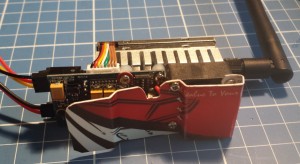Finally got an SD DVR recorder to record some FPV videos over Britanny RC airfield. The setup has a 2.8mm lens on a 700TVL camera and a 2W 5.8Ghz Video transmitter.
The camera gets totally washed out when it’s pointed directly to the sun (I understand some cameras automatically superimposes a black dot of extremely bright objects like the sun).. not really a big issue.
The stock Yagi Antenna’s on the VTx and VRx are good enough, although once the plane is directly overhead and goes through the ‘donut hole’ video signal is lost. Simply shifting position / angle of the receiver or the Video Receivers antenna easily fixes it though. Circular polarized antennas a.k.a. Cloverleaf should give better performance.
Here’s the vid:











